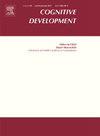When kids juggle it all: Biliteracy instruction and the development of discourse connectedness in L1 and L2 writing
IF 1.8
3区 心理学
Q3 PSYCHOLOGY, DEVELOPMENTAL
引用次数: 0
Abstract
The present longitudinal study explored how bilingual educational contexts shape children's cognitive and linguistic development. Its main goal was to investigate the development of discourse connectedness (measured by long-range connectedness - LSC) in written narratives in Portuguese (L1) and English (L2) by 78 children of a bilingual school in Brazil within a year span (from 2021 to 2022). Participants created a narrative in their L1 or L2 based on a sequence of five images, which were analyzed with the computational tool SpeechGraphs (Mota et al., 2014). Connectedness scores were expected to vary as a function of Language (L1, L2) and of Year of data collection (Time 1, Time 2), favoring, respectively, the L1 and Time 2. The results confirmed our hypotheses, with long-range recurrence (LSC) scores in the L1 narratives higher than in the L2 at both times of data collection. In addition, the longitudinal analysis revealed higher connectedness scores for narratives written in Time 2 in both languages. Overall, our findings indicate that the children's performance in terms of connectedness progressed in a parallel way in the two languages during the school years, with an expected advantage for the narratives written in their dominant language. In addition, they highlight the potential of using SpeechGraphs - a cost-effective, non-invasive computational tool - to analyze children's use of two prestige languages in a particular bilingual educational context.
当孩子们兼顾这一切:双语教学和母语和第二语言写作的话语联系的发展
本研究旨在探讨双语教育环境对儿童认知和语言发展的影响。其主要目标是调查巴西一所双语学校的78名儿童在一年内(从2021年到2022年)葡萄牙语(L1)和英语(L2)书面叙述中的话语连通性(通过远程连通性- LSC测量)的发展。参与者根据五幅图像的序列在他们的第一或第二语言中创建一个叙事,这些图像使用计算工具SpeechGraphs进行分析(Mota等人,2014)。预计连通性分数会随着语言(L1, L2)和数据收集年份(时间1,时间2)的变化而变化,分别有利于L1和时间2。结果证实了我们的假设,在两次数据收集中,第一叙述的远程复发(LSC)得分都高于第二叙述。此外,纵向分析显示,用两种语言在Time 2中写的故事的连通性得分更高。总的来说,我们的研究结果表明,在上学期间,孩子们在两种语言的连通性方面的表现以平行的方式发展,用他们的主要语言写的故事具有预期的优势。此外,他们还强调了使用语音图表(一种成本效益高、非侵入性的计算工具)分析儿童在特定双语教育背景下使用两种威望语言的潜力。
本文章由计算机程序翻译,如有差异,请以英文原文为准。
求助全文
约1分钟内获得全文
求助全文
来源期刊

Cognitive Development
Multiple-
CiteScore
3.20
自引率
5.60%
发文量
114
期刊介绍:
Cognitive Development contains the very best empirical and theoretical work on the development of perception, memory, language, concepts, thinking, problem solving, metacognition, and social cognition. Criteria for acceptance of articles will be: significance of the work to issues of current interest, substance of the argument, and clarity of expression. For purposes of publication in Cognitive Development, moral and social development will be considered part of cognitive development when they are related to the development of knowledge or thought processes.
 求助内容:
求助内容: 应助结果提醒方式:
应助结果提醒方式:


